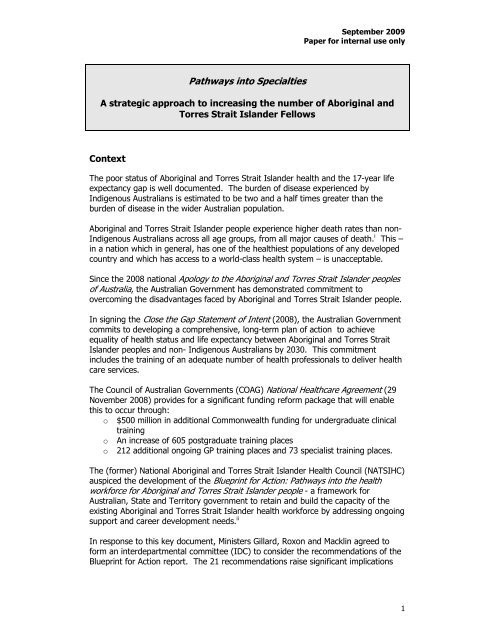View - LIME Network
View - LIME Network
View - LIME Network
Create successful ePaper yourself
Turn your PDF publications into a flip-book with our unique Google optimized e-Paper software.
September 2009Paper for internal use onlyPathways into SpecialtiesA strategic approach to increasing the number of Aboriginal andTorres Strait Islander FellowsContextThe poor status of Aboriginal and Torres Strait Islander health and the 17-year lifeexpectancy gap is well documented. The burden of disease experienced byIndigenous Australians is estimated to be two and a half times greater than theburden of disease in the wider Australian population.Aboriginal and Torres Strait Islander people experience higher death rates than non-Indigenous Australians across all age groups, from all major causes of death. i This –in a nation which in general, has one of the healthiest populations of any developedcountry and which has access to a world-class health system – is unacceptable.Since the 2008 national Apology to the Aboriginal and Torres Strait Islander peoplesof Australia, the Australian Government has demonstrated commitment toovercoming the disadvantages faced by Aboriginal and Torres Strait Islander people.In signing the Close the Gap Statement of Intent (2008), the Australian Governmentcommits to developing a comprehensive, long-term plan of action to achieveequality of health status and life expectancy between Aboriginal and Torres StraitIslander peoples and non- Indigenous Australians by 2030. This commitmentincludes the training of an adequate number of health professionals to deliver healthcare services.The Council of Australian Governments (COAG) National Healthcare Agreement (29November 2008) provides for a significant funding reform package that will enablethis to occur through:o $500 million in additional Commonwealth funding for undergraduate clinicaltrainingo An increase of 605 postgraduate training placeso 212 additional ongoing GP training places and 73 specialist training places.The (former) National Aboriginal and Torres Strait Islander Health Council (NATSIHC)auspiced the development of the Blueprint for Action: Pathways into the healthworkforce for Aboriginal and Torres Strait Islander people - a framework forAustralian, State and Territory government to retain and build the capacity of theexisting Aboriginal and Torres Strait Islander health workforce by addressing ongoingsupport and career development needs. iiIn response to this key document, Ministers Gillard, Roxon and Macklin agreed toform an interdepartmental committee (IDC) to consider the recommendations of theBlueprint for Action report. The 21 recommendations raise significant implications1
















